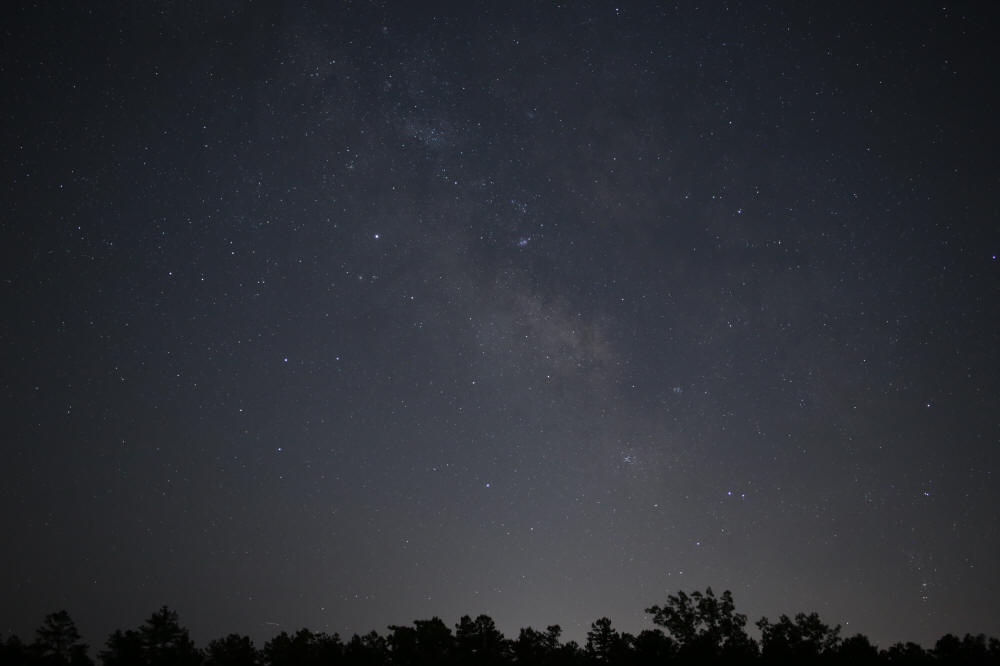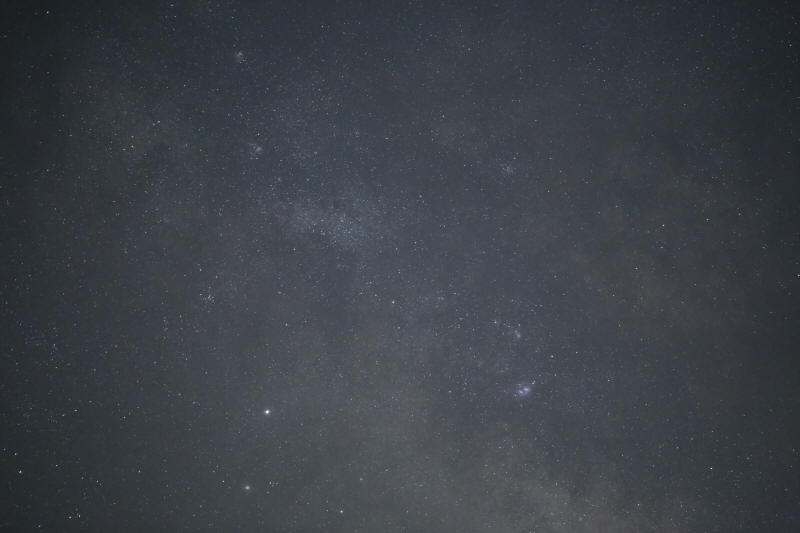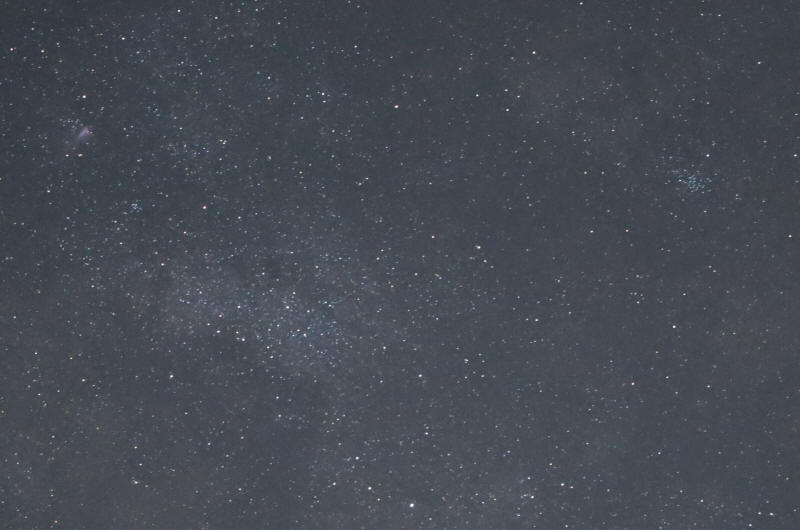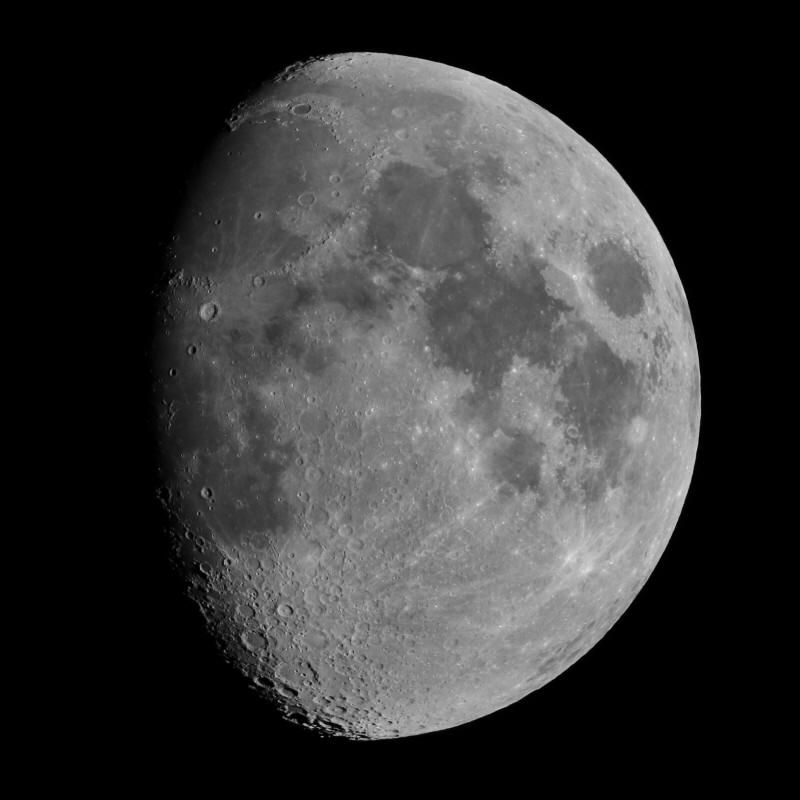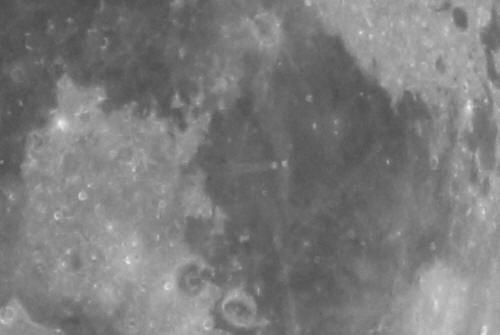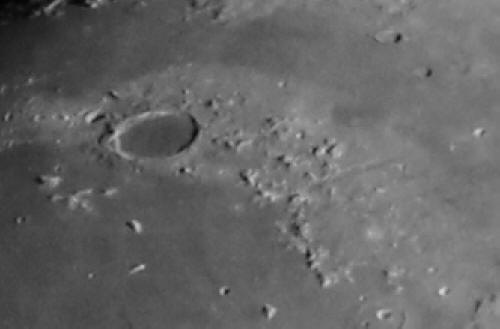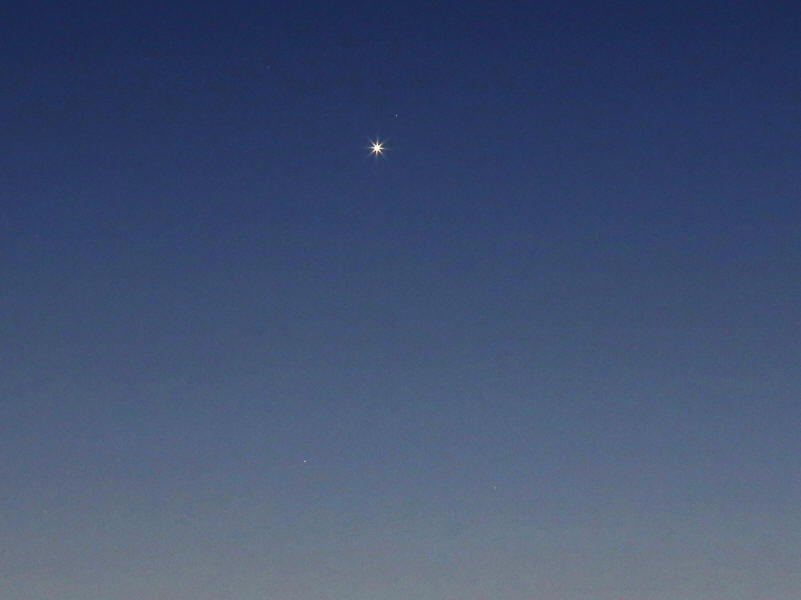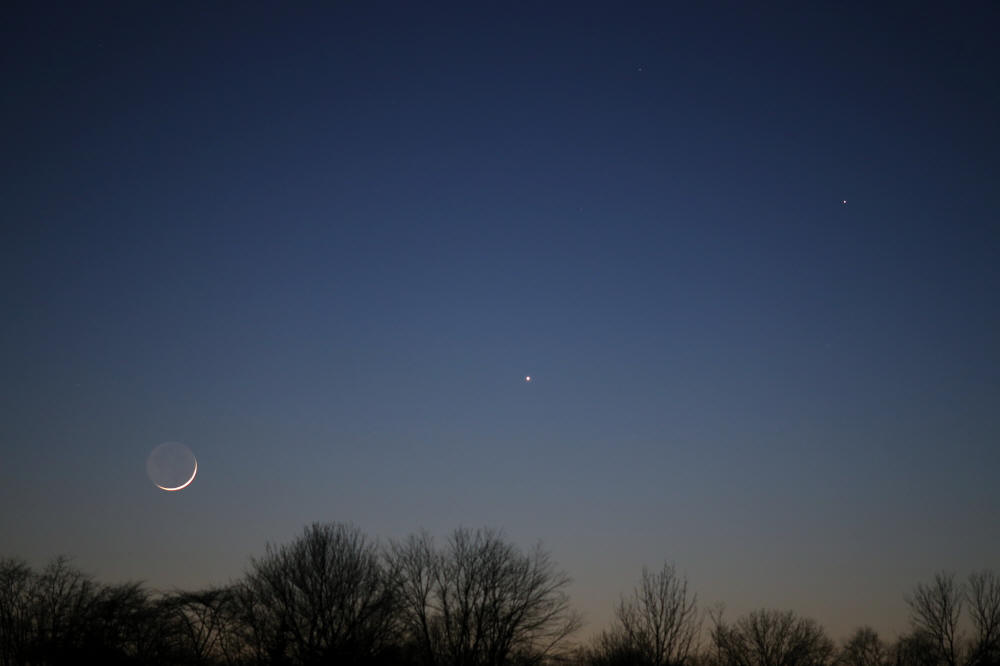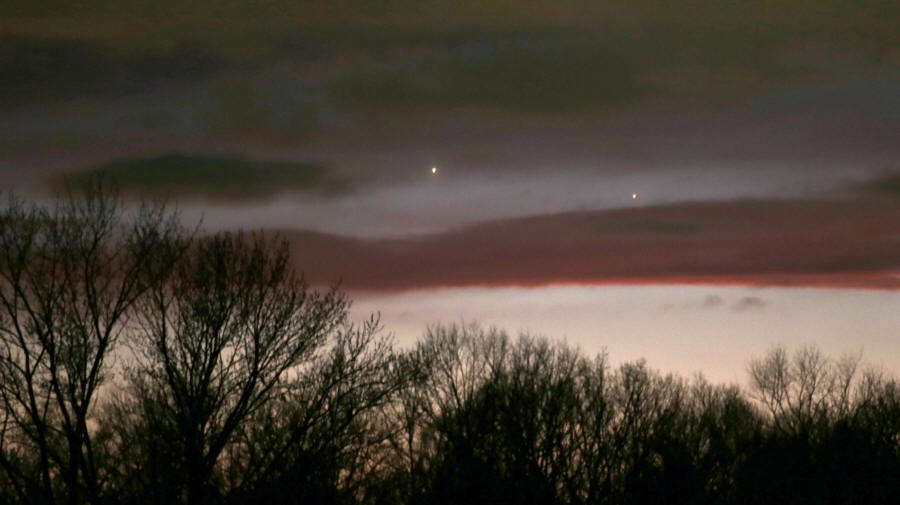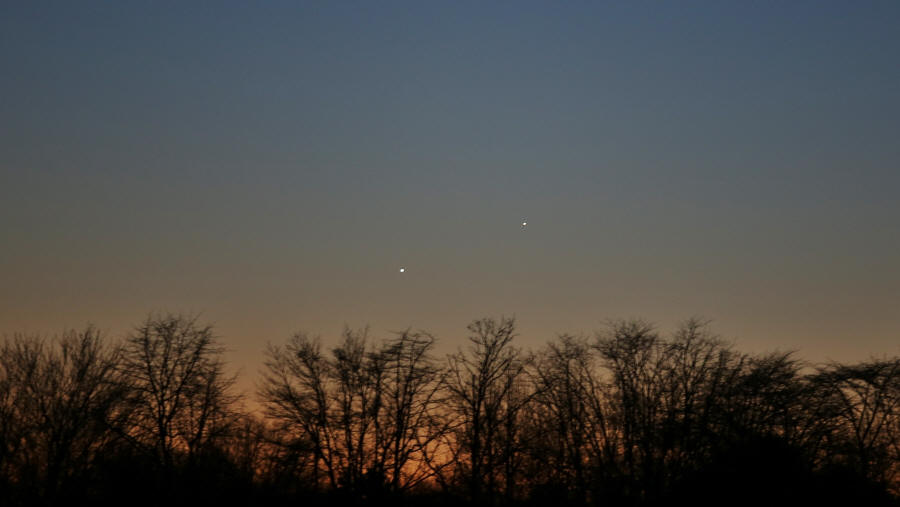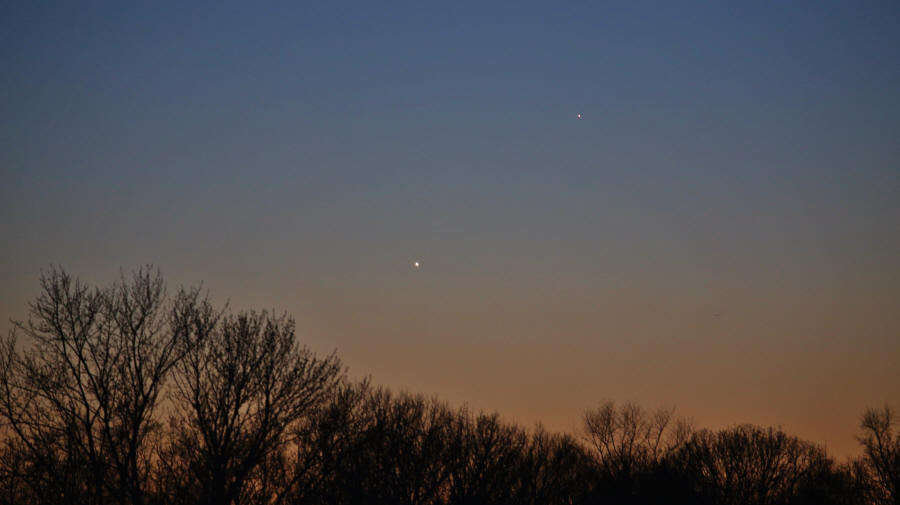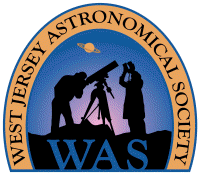(4) Vesta Nears Opposition
June 5, 2018
This picture of the Milky Way region above Sagittarius
was captured on June 5, 2018,
at 12:44 am from Carranza Field in Wharton State Forest, NJ. However,
the Milky Way was not the prime target, rather it was the asteroid (or
minor planet), (4) Vesta.
This is a single frame taken with a Canon 6D digital SLR camera on a
fixed tripod and a Tamron 45 mm f/1.8 lens, which provides a field about
43.5° wide x 30° high. Exposed 4 seconds at f/2, ISO 3,200 and 3,600K
white balance. Other than size reduction for this web page, no
processing was applied. Mouseover for labels.
Note: The object labeled M18 is actually M16.
I went to Carranza in hope of seeing Vesta with unaided eyes since it was at magnitude 5.7 (it will reach magnitude 5.3 at opposition on June 19, more about that here). I arrived just before midnight on June 4 and stayed until about 1 am EDT on June 5. Vesta would transit at 2:13 am, but the almost-third-quarter Moon rose at 12:53 am. The Milky Way through the Summer Triangle and continuing down into Sagittarius was prominent, but not billowing. The air seemed moist after heavy rain over the weekend and dew was forming on my camera and tripod. However, it was quite pleasant to be under a starry sky for a change, and sweeping the sky with 15x56 binoculars revealed numerous deep-sky objects, especially in the pictured Milky Way. And for a sonic background, the chorus frogs were going strong at nearby Skit Branch.
Vesta was easily visible in the binoculars, but I was not able to make a definite sighting of it with unaided eyes. I think I might have glimpsed Vesta with averted vision a couple of times when I was able position M24, the Sagittarius Star Cloud, in the averted sweet spot (nice view) and I thought I was seeing a ghostly outline of the dark Prancing Horse Nebulae (which includes the dark Pipe Nebula), but Vesta was much too fleeting to be claimed as a sighting. One has to guard against the brain filling-in things that are expected, but not really visible. I was also unable to see M13 with unaided eyes, something I've done many times in the past, even though it was virtually at the zenith. Perhaps the transparency wasn't that good, or perhaps advancing age is catching up with my eyes. However, looking at SkyTools, Vesta was 28° altitude at 12:44 am, so the airmass for it was 2.1, which yielded a mean extincted magnitude of 6.6, which would indeed be dimmer than the nominal magnitude 6 limit for unaided eyes (and the dimmest I've confirmed seeing in the past from New Jersey is magnitude 6.1). I also failed to see M51 (about 60° altitude) in the 15x56s, which I was able to do without difficulty last month at Atsion in Wharton State Forest.
Note that Atlantic City, with its attendant light pollution, is only about 30 miles away in nearly the same direction as Vesta in the picture (≈160° azimuth), hence the light cone rising from the tree tops in the middle of the frame. Last, but not least, I need a better way to block Saturn besides a hand at the end of my outstretched arm, which quickly becomes tiresome; perhaps a piece of cardboard at the end of a stick? Saturn may not seem particularly bright in a suburban sky, but under a dark sky looking for a nearby faint object (Vesta was less than 7° away), it looks bright and becomes disruptive. In any case, a couple more weeks remain before Vesta's opposition and maximum brightness — and before the moon interferes. Let's hope for some more clear nights! Scroll down for reports on later attempts.
The image below was taken at 12:19 am EDT with the 6D and a Canon 100 mm f/2.8L macro lens on a fixed tripod, providing a field about 20° wide x 14° high to better show Vesta. Exposed 4 seconds at f/2.8, ISO 12,800, 3,600K white balance. No processing was applied besides size reduction. Mouseover for labels. Note: The object labeled M18 is actually M16.
The image below is a 41% crop of the previous image taken with the 100 mm lens, providing a field about 8.4° wide x 5.6° high. Again, no processing was applied besides the cropping and size reduction. Vesta was located in front of a small asterism of several stars in the magnitude 8 to 10 range that was shaped a bit like an arrowhead. The stars of the "arrowhead" were visible in the 15x56 binoculars, but Vesta is currently moving about 0.22°/day west (retrograde motion, to the right in this view), so it was only there temporarily. Mouseover for labels.
Refer to the separate Vesta page for observation updates.
The Great Courses Ad
Mystery Objects
in the Hyades and the Foot of Castor
The Waxing Gibbous Moon
May 24, 2018
The 9.6-day-old, 80.2% illuminated, waxing gibbous Moon was captured on May 24, 2018, at 10:46 pm EDT from Maple Shade, NJ. This is a single frame taken with a Canon 7D Mark II digital SLR camera at the prime focus of a Stellarvue SVA 130T f/7 triplet apochromatic refractor (910 mm focal length) on an altazimuth mount. It was cropped to a third of the sensor's area, yielding a field about 0.6° square. It was exposed 1/1000 second at f/7, ISO 400, which is an exposure equivalent to the "looney eleven" rule-of-thumb. Besides cropping, only mild adjustment was applied, mainly by reducing color saturation to zero. This is a direct view with the zenith up, south down and celestial east to the left.
The image below is a severe crop of the original frame (9% of the linear dimensions, or less than 1% of the original area of the frame) producing a field 7.5 x 5.0 arc minutes. It shows the craters Messier and Messier A in Mare Fecunditatis, two-thirds of the way from the lunar center to the right limb as pictured above. Messier A is on the left and has prominent rays extending to the lunar west (left). The two craters and the rays are believed to be the result of a low-angle impact.
The image below is also a severe crop of the original frame (6% of the linear dimensions, or 0.4% of the original area of the frame) producing a field 5.1 x 3.4 arc minutes. It shows the crater Plato (left of center) and Vallis Alpes (the straight gouge right of center). They're near the top of the moon in the full image.
Four (4) ISS + Cygnus Passes Overnight
May 23-24, 2018
Six (6) ISS Passes, One (1) with Cygnus, Overnight
May 21-22, 2018
Antares Rocket Launch, taking the Cygnus
Cargo
Spacecraft, OA-9, to the ISS
May 21, 2018
Jupiter, GRS & Io + Shadow Transits
May 8, 2018
The Crescent Moon in the Hyades
April 18, 2018
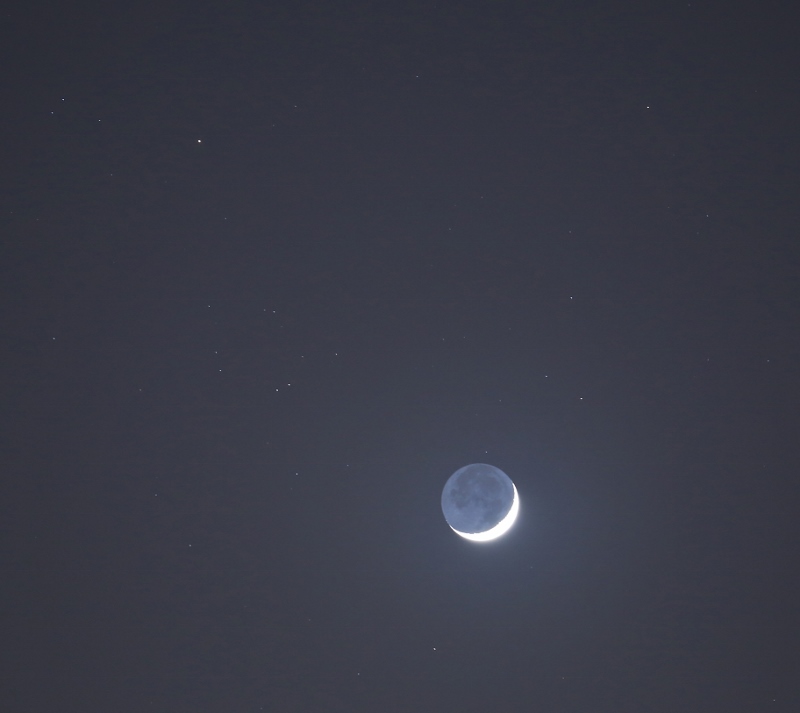
The two-day-old, 11% illuminated and earthshine-filled Crescent Moon was in the Hyades star cluster on April 18, 2018, when this image of them was captured from Maple Shade, NJ, at 8:54 pm EDT, 74 minutes after sunset in a hazy sky, soon to become cloudy. This is a single frame taken with a Canon 6D digital SLR camera and a Tamron 150 to 600 mm f/5-6.3 zoom lens (on a fixed tripod) set to 250 mm focal length, then cropped to about three-quarters of the original frame, producing a field 5.5° wide x 4.9° high. It was exposed 1.6 seconds at f/5.6, ISO 1600. Mouseover for labels. All of the stars here are in Taurus the Bull, so the labeled Bayer letter or Flamsteed number would be suffixed "Tauri." The blue V-shaped lines frame the face of the Bull in the Hyades. The horns would extend about 15° more-or-less vertically from Aldebaran (α) and Ain (ε) to Zeta (ζ) and Beta (β) Tauri respectively (β = Alnath). Note: The labels for Theta 1 & 2 (θ¹ & θ²) are reversed.
Notice the magnitude 5.6 star, 63 Tauri, just above the moon. I saw it near the lunar limb on the camera's viewing screen during the session, and reviewing circumstances afterwards with SkyTools, saw that it was occulted by the moon at 9:08 pm (the moon is moving eastward, nominally to the upper-left in this view, about its own half-degree diameter per hour). Looking through the images, the last one with 63 Tauri visible (below) was taken at 9:07 pm EDT, 13 minutes later.
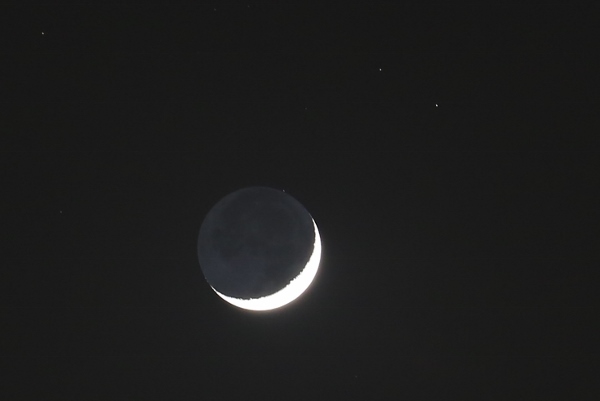
63 Tauri had vanished in the following frame that was time-stamped 9:08 pm (not shown). Taken with a Canon 6D digital SLR camera, which has an internal GPS that sets the clock, and a Tamron 150 to 600 mm f/5-6.3 zoom lens (on a fixed tripod) set to 205 mm focal length, then cropped to about one-quarter of the original frame, producing a field 2.7° wide x 1.8° high. It was exposed 1.3 seconds at f/5.6, ISO 800. Mouseover for labels.
Venus and Uranus
March 30, 2018
The planets Venus and Uranus were at conjunction on March 28, 2018, and less then 5 arc minutes apart after sunset. However, it was cloudy that night, as it was on the preceding and following nights, March 27 & 29, when they were little more than 1° apart. Finally, on March 30, 2018, despite rain in the afternoon and a poor weather forecast for the evening, it cleared out nicely shortly before sunset at 7:22 pm EDT. This picture of them was taken at 8:13 pm from the baseball field complex in Maple Shade, NJ, with a Canon 6D digital SLR camera and a Canon 200 mm f/2.8L lens (on a fixed tripod), then cropped to about half the original size for a field 5.0° wide x 3.7° high. It was exposed 0.8 second at f/8, ISO 1600.
In the picture, brilliant Venus is shining at magnitude -3.9, so it's overexposed and shows a crown of diffraction spikes generated by the lens diaphragm. The magnitude +5.9 star HD 11257 is 15 arc minutes from Venus at the 1 o'clock position, the magnitude +4.3 star Omicron Piscium is 2.1° from Venus at the 7 o'clock position and barely-visible magnitude +5.9 Uranus is 2.3° from Venus at the 5 o'clock position (mouseover for labels). At the time of the picture, Venus was at 8.2° altitude and Uranus was at 6.0° altitude. Venus is moving eastward from the sun, and becoming higher in the evening sky, following superior conjunction on January 9, 2018. Uranus is dropping in the evening sky and will be at conjunction with the sun on April 18, 2018.
The 9.8 magnitude difference between Venus and Uranus is equivalent to a difference of 8,300 times in brightness, or 13 photo stops, hence the difficulty in showing them both with a single exposure and no localized processing to enhance Uranus. In addition, the difference in the already-low altitude causes greater atmospheric extinction of Uranus, and the noticeable twilight gradient also diminishes Uranus' visibility in the photo. Uranus and Omicron Piscium could not be seen with 16x70 binoculars during the March 30 session from 8:00 and 8:30 pm. My last visual sighting of Uranus (using an 80 mm apo refractor at 72x) was on March 26 when it was about 2.4° above Venus. It was not easy to see.
The Crescent Moon, Venus and Mercury
March 18, 2018
The 1.5-day-old Crescent Moon joined the planets Venus and Mercury in this view captured on March 18, 2018, from Swede Run in Moorestown, NJ, at 8:01 pm EDT, 51 minutes after sunset. The Moon was at 4.3° altitude and 2.5% illuminated. Venus, 3.9° from the moon, was at 5.3° altitude and magnitude -3.9. Mercury, 3.8° from Venus, was at 7.2° altitude and magnitude +0.4. It's a single uncropped frame taken with a Canon 6D digital SLR camera and a Canon 200 mm f/2.8L lens (on a fixed tripod). It was exposed 1/10 second at f/2.8, ISO 1600, daylight white balance. Mouseover for labels. Here's my 2018 Mercury sighting page.
Venus and Mercury
March 3, 4 & 5, 2018
In early March 2018, both Venus and Mercury were in eastern elongation and were visible low in the west after sunset. At time, Mercury was moving eastward more rapidly than Venus and passed it, reaching conjunction in geocentric right ascension on March 5 at 1 pm EST. Their appulse (closest approach) for an observer at 40°N-75°W, only a few miles from Maple Shade and Moorestown, NJ, would be on March 4 at 1 am EST. The closest visible approach was on the evening of March 3 when they were 1° 05' apart at 6:30 pm EST. On March 4, they were 1° 09' apart and on March 5, they were 1° 29' apart at 6:30 pm. During these three days, Venus was at magnitude -3.9 while Mercury was at magnitude -1.2 on March 3 & 4, magnitude -1.1 on March 5. Venus was seen with unaided eyes on all three dates, but obvious on the clear evenings of March 4 & 5. Mercury was also readily visible with unaided eyes on March 4 & 5. Of particular note on March 5, both were seen with 10x50 binoculars at 5:52 pm, 4 minutes before sunset, when Mercury was at 13.5° altitude. Check the Mercury 2018 page for more details about visual observations on these dates, under Elongation #2.
The pictures below show Venus and Mercury on March 3, 4 & 5, 2018. The scale varies a little between them, but they clearly show Mercury (on the right) increasing in altitude relative to Venus on successive evenings. Mouseover for labels.
March 3, 2018, at 6:36 pm EST (42 minutes after sunset) from the baseball field complex in Maple Shade, NJ. Canon 6D digital SLR camera (on a fixed tripod) and a Sigma 70 to 300 mm, f/4-5.6 zoom lens set to 300 mm focal length, then cropped to about 60% of the original size (and a 16:9 ratio), which yielded a field about 4.6° wide x 2.6° high. It was exposed 1/6 second at f/5.6, ISO 800.
March 4, 2018, at 6:37 pm EST (42 minutes after sunset) from Swede Run in Moorestown, NJ. Canon 6D digital SLR camera and a Canon 70 to 200 mm, f/2.8L zoom lens (on a fixed tripod) set to 190 mm focal length, then cropped to about 65% of the original size (and a 16:9 ratio), which yielded a field about 7.5° wide x 4.3° high. It was exposed 1/20 second at f/2.8, ISO 800.
March 5, 2018, at 6:40 pm EST (44 minutes after sunset) from the baseball field complex in Maple Shade, NJ. Canon 6D digital SLR camera and a Tamron 150 to 600 mm f/5-6.3 zoom lens (on a fixed tripod) set to 329 mm focal length, then cropped to about 84% of the original height (for a 16:9 ratio), which yielded a field about 6.2° wide x 3.5° high. It was exposed 1/4 second at f/5.6, ISO 1600.
Click here for the previous page.
Click here for an index to previous SJAstro pages.
